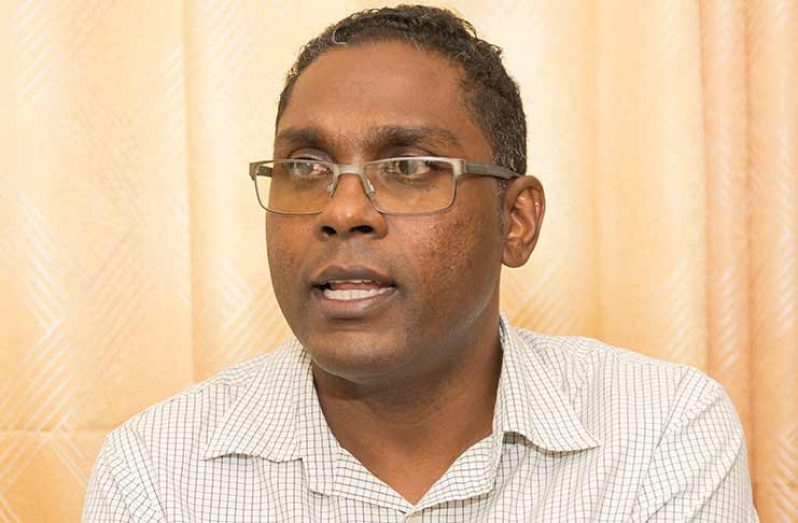AS concerns loom about the negative effects of mercury in mining, Conservation International Guyana (CIG) is working to provide solutions to phase out the use of the toxic material and reduce its harmful effects on the forest.
These efforts are being pursued through the 2018-2022 Global Environment Facility- Global Opportunities for Long-term Development (GEF-GOLD) project and the Addressing Drivers of Deforestation project.
The former is being funded by GEF with a sum of US$3M over a four year period while the latter is being funded by Norwegian Government and has been ongoing for some two years now.
Collaborating locally towards these efforts are the Ministry of Natural Resources, the Guyana Gold and Diamond Miners’ Association (GGDMA), the Guyana Geology and Mines Commission (GGMC) and the National Toshaos Council (NTC).
In an exclusive interview with the Guyana Chronicle, Conservation International Guyana’s Director of Field and Implementation, René Edwards, revealed that along with much community engagement, plans are being put in place to provide alternative and safe mining equipment to miners.
Guyana’s gold mining forms a core part of its economy, contributing to approximately 11 per cent of the country’s Gross Domestic Product (GDP) in 2016 with a production of some 712, 707 ounces of the precious metal.
Contributing to the majority of this production are Artisanal, Small and Medium (ASM) –scale miners, many of whom hail from indigenous communities and rely on gold as a main source of livelihood.
However, as the country seeks to transition into a green economy, gold mining presents a threat to natural capital through negative impacts on the ecosystem such as the pollution of waterways and deforestation.
CIG presents data which show that an estimated 90 percent or 53,517 hectares of the country’s forest have been cleared between 2009 and 2014 while the use of mercury for amalgamation pollutes freshwater, harming aquatic animals and humans.
Through its Responsible Mining Initiative, CIG will focus attention on how mining can be conducted responsibly with respect to the environment, communities and the economy.
CIG will work along with stakeholders to develop policies and other solutions to reduce the impact of mining and to ensure that mining sites are rehabilitated for planned after-use.
It also aims to ensure that gold mining activities are only carried out in places where viable deposits are found and that more efficient methods are used to improve gold recovery.
These methods are to be employed following a changeover to new mercury-free mining resources which stakeholders involved may soon provide to the sector.
“The miners need to have support. A lot of them are small, artisanal miners who don’t have the money to invest in or to test these mercury-free equipment. So, the project will be working with the private sector and [local stakeholders]…on making sure we have appropriate mining equipment suited for the different types of geology in Guyana,” Edwards said.
He elaborated that through a series of assessments of local and international markets along with expert advice on the right type of equipment needed, these will be acquired.
“Through a process we will select the type of equipment, we’ll bring it to Guyana and then we’ll work with the miners to test it in the fields,” Edwards said, adding that funding for this will come from GEF and the Norwegian Agency for Development Cooperation (NORAD).
To help with this equipment phase out, CIG has proposed a market approach which will see gold buyers requesting responsibly ASM gold and gold products which will in turn compel miners to meet the environmental and health-friendly standards the country hopes to set.
This will see the country’s gold exports being rebranded as ‘El Dorado Gold’.
“If we look at this value chain, especially from the marketing side, and we make sure that whoever is buying the gold is really looking at standards and making sure that wherever they buy the gold, that gold is responsibly produced, it becomes very important [to local miners],” he explained.
When it comes to ensuring that miners adhere to old and new policies, Edwards said that the Government, through the Natural Resource Ministry, will continue to improve upon its monitoring of the sector using technology.
The projects are also guided by a Rights Based Approach which takes into consideration stakeholder involvement, including indigenous communities which will all work together to design solutions for the country.
Added to this, a Sustainable Landscape Approach is being undertaken by CIG to ensure that projects implemented at main mining areas, such as the South Rupununi, Lower Potaro and Upper Potaro, are done to the benefit of all parties.
Assisting in this regard is the Government’s Plan of Action for Regional Development, established by the Ministry of Communities.
Together, CIG’s efforts on mining serve to meet the overall goal of Guyana’s commitments under the Minamata Convention signed in October 2013.
It is aimed at protecting humans and the environment around the world from mercury emissions caused by human activities.



.jpg)








